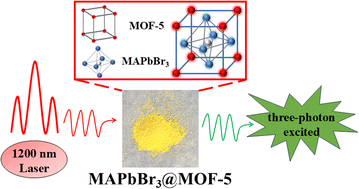Organometallic halide perovskites have attracted attention due to their excellent optical properties. However, the inherent instability limits their wide application in the field of optoelectronics. In this study, a distribution immersion method was used to embed MAPbBr3 perovskite quantum dots into mesoporous MOF-5 microcrystals, constructing an effective host–guest structure. Compared with MAPbBr3 quantum dots, the MAPbBr3@MOF-5 composite not only exhibits superior optical performance but also significantly enhanced long-term stability and thermal stability. Nonlinear optical analysis shows that under the excitation of near-infrared femtosecond laser pulses, the MAPbBr3@MOF-5 composite exhibits significantly enhanced multiphoton absorption capability. Notably, its effective three-photon absorption coefficient (α3η ≈ (27.4 ± 3.1) × 10−5 cm3 GW−2) is an order of magnitude larger than that of MAPbBr3. These outstanding characteristics indicate that the MAPbBr3@MOF-5 composite has great potential for applications in photonics and information communication, especially in the manufacture of multifunctional nonlinear optical devices and future micro–nano photonic integration technologies.
